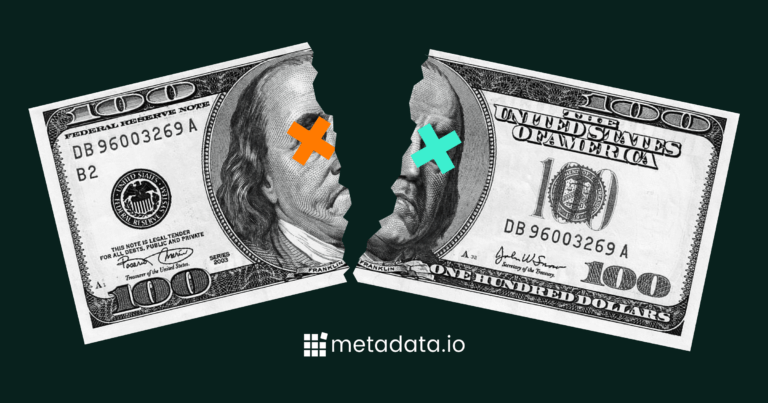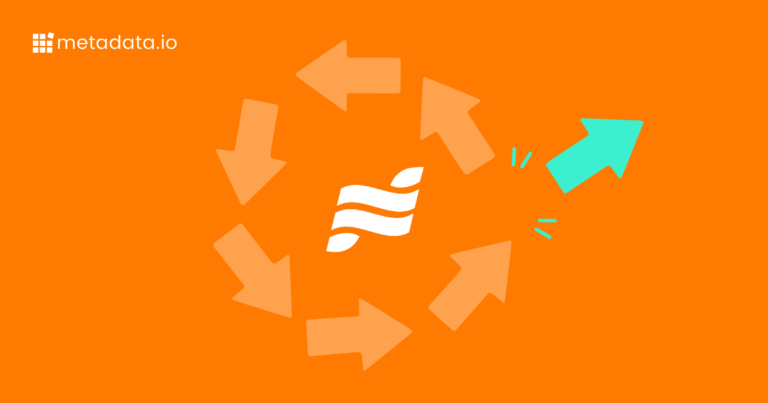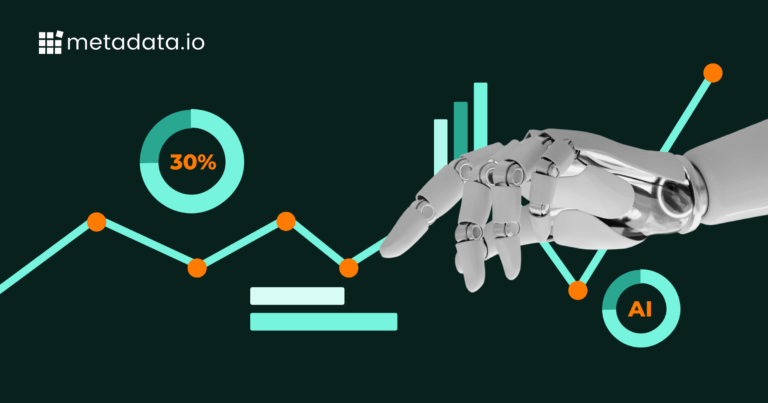B2B Marketers—Meet Your New BFF: How AI Writing Is Changing the Game
According to Statista, average monthly searches for “AI” increased by 284% between June 2022 and March 2023. You can thank B2B marketers for a good chunk of those searches.
While there’s no denying that artificial intelligence (AI) is evolving quickly and manifesting in some rad ways, there’s also no denying that B2B marketers are paying very close attention.
Their most pressing question right now: How will AI impact my job? Wait, actually, do I still have a job?
We sat down with May Habib, co-founder and CEO of Writer—a generative AI company that just closed a $100mm Series B funding round—to learn how companies like hers save marketers time, money, and a ton of headaches.
What bottlenecks will AI break open for B2B marketers?
Let’s address the elephant in the room and punt it as far away as possible: Marketers, your jobs are safe. According to May, “Marketers aren’t going anywhere…in the hands of experts, AI is truly transformational.”
We couldn’t agree more. (By the way, May founded Writer in 2020, aka before AI writing tools were in the spotlight.)
The robots aren’t taking over…at least not anytime soon. We can’t chart AI’s future course with absolute certainty, and we understand challenges are undoubtedly on the horizon. But the immediate marketing implications are brighter than Super Star, a power-up that grants Mario invincibility.

For better or worse, AI writing tools won’t make you invincible, but they can make you more efficient and productive. As a B2B marketer doing everything possible to maximize their time (and budget), that should light up your world.
Imagine this: You’re on your umpteenth cup of coffee, and every second feels like an hour. Your task? Write an engaging blog post explaining how your product can transform your customers’ workday (much like we’re doing with this post). Yet, the words escape you. It’s time to give up—the blank page won again.
This scenario probably isn’t too hard to imagine. Whether you’re working on an article, social post, a landing page, or a script for an upcoming webinar, the blank page defeats even the best of us.
But it doesn’t have to.
Now imagine this: You ask a tool like Writer to create an outline for your article with a prompt like, “Outline an article about how [insert your product here] can help our customers be more productive.” A few seconds later, an in-depth outline—H1, H2, and H3s included—appears on your screen.
You make a few tweaks to the outline and ask Writer to create a draft. And voilà, you have the first version of your article in less time than it’d take you to brew another cup of coffee.
This is just the start of what’s possible with AI writing tools.
Here are some prompts you could give a tool like Writer:
- Write a blog post based on this webinar recording
- Craft an introduction for our “state of technology” report
- Provide an answer to an FAQ
- Compose emails that promote our product to prospects
- Summarize this article and create a social media post
- Take this talk track from a conference and turn it into a recap article for our blog
You can even enhance content with prompts like, “Personalize these emails based on product adoption metrics” or “What data points can I add to this article to make it more compelling to our target audience?”
Beyond content creation, most AI tools, including Writer, can edit content to ensure it aligns with brand, editorial, and style guidelines. The AI can also be your brainstorming buddy, turning a prompt into dozens of article titles or campaign ideas.
The AI offers more than just content and ideas—it also gives you back time and money. Instead of spending hours staring at a blank page or sinking unnecessary hours into an article, the AI does the heavy lifting, allowing you to reinvest your time into higher-return tasks, like creative strategy and experimentation.
If AI is so great, why aren’t all marketers using it?
Despite features and capabilities that’d impress the Jetsons, AI writing tools are still in their infancy. You wouldn’t believe it by the number of people posting about them on LinkedIn, but we’re still years away from AI writing tools becoming mainstays in marketers’ tech stacks.
Some of the hesitation is natural; marketers steer clear of tactics and technology they don’t understand. We’ve seen that with almost everything related to the Internet, including social advertising. AI writing tools are no different, and marketers just need time to warm up.
Also keeping marketers at bay: SEO and the dreaded (potential) dip in organic website traffic.
Google, in particular, has taken a firm stance against marketers using AI recklessly, implementing its helpful content system to ensure people only see “original, helpful content created for people in search results.” (READ: Content not created by robots.) For search engines like Google, AI-generated content is public enemy #1.
We won’t pretend to understand exactly how Google’s algorithm ranks content, including that of the AI variety. Still, we know that Google frowns upon content that lacks authenticity, relevance, and value. It’s safe to say AI-generated content typically lacks those attributes.
Not convinced? Take a look at these screenshots courtesy of Glenn Gabe, SEO Consultant at G-Squared Interactive. They show marked declines in organic traffic for two websites following Google’s recent helpful content update.

These are just two examples of Google’s wrath. While a sharp decline in organic traffic doesn’t automatically find a website guilty of over-relying on AI, it does mean that Google’s taken notice—and that’s a big problem for any marketers, but especially those relying on organic traffic sources amid ongoing cuts to paid ad budgets.
How to get started using an AI tool like Writer
Getting started with an AI tool like Writer is relatively simple. Most, if not all, of the tools come with ready-to-use templates.
For marketers using Writer, that means access to dozens of templates to help them quickly create blog headlines, outlines, posts, meta descriptions, press releases, email subject lines, product descriptions, and release notes. Marketers can take it a step further by creating custom templates designed to meet their unique content requirements—think character counts, input types, and output length.
But getting started with AI writing tools is one thing. Thriving with them is another.
As you start your journey with AI writing tools, remember:
- Set clear goals and expectations: Don’t expect the AI to do everything. Instead, identify the friction points in your content-creation process and determine how AI can help you break open those bottlenecks.
- Put skilled writers in the driver’s seat: AI writing tools are powerful, but they’re nothing without people steering them in the right direction. It’s vital to put skilled writers in the driver’s seat—writers who understand how to produce high-quality original content and make the most of evolving technology.
- Train the AI: Maximizing the value of AI writing tools requires time, patience, and a commitment to training the technology. In other words, you shouldn’t expect perfect outputs from the AI on day one; it’s an iterative and adaptive process. Marketers using Writer can flatten AI’s learning curve by uploading their top-performing content, which Writer will use to learn more about the team’s context, preferred language and tone, brand voice, and more.
Once up and running with an AI writing tool, marketers can offload previously time-consuming tasks, produce content in far less time, and use those time savings to be more deliberate and strategic with everything they do.
AI isn’t just for content creation—it’s for targeting, too
For now, AI writing tools are best suited for predictable content types that follow repeatable formats, like blog posts, case studies, and social posts. But that’s not the only way to use AI to supercharge your demand generation strategy.
AI is also well-suited for smart targeting, a tactic designed to track users online using criteria like location, device type, purchase history, browsing period, and site visits. From there, you can personalize your campaigns and tailor creative and messaging to the unique needs of your target audience.
Not only does smart targeting allow you to personalize campaigns without significant manual work, but it can also drive more conversions, improve relationships with customers, and lower costs.
When we sat down with May, she said something simple yet powerful: “AI can feel like magic to your teams.” She’s spot on. Whether you use AI to speed up content creation or get laser-focused with your targeting, the technology is truly transformational.
That said, regardless of your use case, you must remember that no matter how advanced the technology becomes, you’ll always have something it doesn’t: intuition. AI tools like Writer, ChatGPT, and Google’s Bard, are powerful productivity assistants, but they don’t understand how to market to humans.
Only you do. Keep that top of mind, use the tools responsibly, and reap the pipeline-boosting benefits of AI writing tools.


